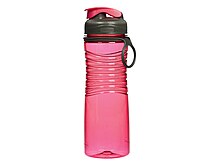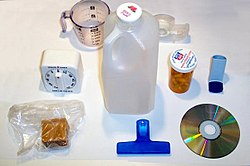Tritan copolyester
You can help expand this article with text translated from the corresponding article in French. (December 2023) Click [show] for important translation instructions.
|

Tritan, a copolymer offered by the Eastman Chemical Company since 2007, is a transparent plastic intended to replace polycarbonate, because of health concerns about Bisphenol A (BPA).[1][2] Tritan is a copolymer made from three monomers: dimethyl terephthalate (DMT), cyclohexanedimethanol (CHDM), and 2,2,4,4-Tetramethyl-1,3-cyclobutanediol (CBDO).[3] Tritan (PCTG) is made without using any bisphenols or phthalates.
Eastman Tritan cannot be used for hot beverages (like hot water, coffee or tea) and is recommended only for usage temperatures below 60 °C, as it starts to deteriorate at temperatures above 80 °C.[4][5]
In April 2008, Nalgene announced it would phase out production of its outdoor line of polycarbonate containers containing the chemical bisphenol A.[6] Nalgene now uses Tritan as a replacement for polycarbonate, as it does not contain BPA.[7]
Health controversy
[edit]In 2011, a neurobiologist at the University of Texas at Austin, George Bittner, published an article claiming that most polymers, including Tritan, contained other materials with estrogenic activity.[8]
The Eastman Chemical Company sued, and after a jury ruled in Eastman's favor, the Court barred Bittner from making claims about Tritan's oestrogenic activity.[1]
Similar products
[edit]Other manufacturers have developed similar products including the French Arc Holdings's Kwarx since 2006,[9] the German Glaskoch (Leonardo) Teqton since 2009[10] and the South-Korean SK Chemicals' Ecozen, a glycol-modified polyethylene terephthalate (PETG) since 2010/2011.[11] Other manufacturers propose polypropylene (PP)[12] or methylstyrene (MS) as alternatives to Tritan.
Name confusion
[edit]Tritan[13] can also refer to a type of so called unbreakable glass originally developed by the German Zwiesel Kristallglas in 2002 together with University of Erlangen–Nuremberg.[14][15] Its name is derived from titanoxide (titanium oxide in English). In 2012, the Zwiesel Kristallglas company introduced Tritan Protect.[15][16][17] Confusingly, although both are unrelated, Zwiesel Tritan glass and Eastman Tritan copolyester are both advertised as "shatter protected" and are used in the production of drinking glasses as replacements for traditional glasses, despite their different material properties.
See also
[edit]- Superfest (a chemically hardened glass also known as Ceverit or CV-Glas)
- Gorilla Glass
- Borosilicate glass (a type of heat-resistant glass)
References
[edit]- ^ a b Glausiusz, Josie (2014). "Toxicology: The plastics puzzle". Nature. 508 (7496): 306–308. Bibcode:2014Natur.508..306G. doi:10.1038/508306a. PMID 24740050. S2CID 4454912.
- ^ "Bisphenol A: Kunststoff mit Nebenwirkungen". www.spektrum.de (in German). Retrieved 2024-02-29.
- ^ Osimitz, T. G.; Eldridge, M. L.; Sloter, E.; Welsh, W.; Ai, N.; Sayler, G. S.; Menn, F.; Toole, C. (2012). "Lack of androgenicity and estrogenicity of the three monomers used in Eastman's Tritan copolyesters". Food and Chemical Toxicology. 50 (6): 2196–2305. doi:10.1016/j.fct.2012.02.010. PMID 22343188.
- ^ "Tritan, Edelstahl oder Glas? Die Vor- und Nachteile der verschiedenen Trinkflaschen-Materialien". boddels.de (in German). 2021-03-06. Archived from the original on 2024-01-19. Retrieved 2024-05-15.
- ^ "Is Tritan Plastic Better Than Traditional Plastic?". www.greenhive.io. Archived from the original on 2024-05-01. Retrieved 2024-05-15.
- ^ "Nalgene to Phase Out Production of Consumer Bottles Containing BPA". Reuters. 2008-04-18. Archived from the original (PDF) on 2014-04-30. Retrieved 2013-02-07.
- ^ "Nalgene Choice". Archived from the original on 2016-03-02. Retrieved 2008-09-29.
Requires Adobe Flash
- ^ Yang, Chun Z.; Yaniger, Stuart I.; Jordan, V. Craig; Klein, Daniel J.; Bittner, George D. (2011). "Most Plastic Products Release Estrogenic Chemicals: A Potential Health Problem That Can be Solved". Environmental Health Perspectives. 119 (7): 989–996. doi:10.1289/ehp.1003220. PMC 3222987. PMID 21367689.
- ^ Carter, Felicity (2006-05-23). "'Unbreakable' glass launched". Decanter. Retrieved 2024-02-29.
- ^ "twenty4 - erste Glasserie von LEONARDO aus dem Glasmaterial TEQTON® - Pressemeldung vom 17.08.2009". www.perspektive-mittelstand.de. Retrieved 2024-02-29.
- ^ https://www.ferroplast.com/pdf/Ecozen_Brochure.pdf
- ^ "Polypropylen statt Tritan". ISYbe die nachhaltige Trinkflasche (in German). Retrieved 2024-02-29.
- ^ register.dpma.de Brand Tritan
- ^ "Wohnen mit Glas". Handelszeitung (in Swiss High German). Archived from the original on 2023-12-29. Retrieved 2024-01-10.
- ^ a b Handelsblatt Unternehmensportrait "Schott Zwiesel – Das Kristallglas", 2012-12-18. https://www.handelsblatt.com/marken-des-jahrhunderts/unternehmensportraet-schott-zwiesel-das-kristallglas/7536832.html
- ^ "TRITAN Kristallglas - Zwiesel Kristallglas AG" (in German). 2020-09-29. Archived from the original on 2020-09-29. Retrieved 2024-01-10.
- ^ Zwiesel Kristallglas AG (ed): Zwiesel Kristallglas AG. Perfektion und Leidenschaft. Print-Consult, München 2005. pp. 31, 49.


